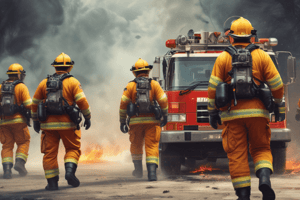Podcast
Questions and Answers
What is the purpose of nonattack postures in firefighting?
What is the purpose of nonattack postures in firefighting?
- To attack the fire aggressively
- To evacuate civilians
- To protect surrounding property and the environment (correct)
- To create fire breaks
When are defensive attacks used in firefighting?
When are defensive attacks used in firefighting?
- When creating fire breaks
- When patrolling for fire brands
- When firefighters want to advance into the fire building
- When the risk to firefighters is too great (correct)
What do offensive attacks involve in firefighting?
What do offensive attacks involve in firefighting?
- None of the above
- Patrolling for fire brands
- Creating fire breaks
- Advancing into the fire building with hose lines or other extinguishing agents (correct)
What determines which firefighting strategy to use?
What determines which firefighting strategy to use?
What is the goal of defensive attacks in firefighting?
What is the goal of defensive attacks in firefighting?
What is the collapse zone in firefighting?
What is the collapse zone in firefighting?
What are key considerations during a defensive attack in firefighting?
What are key considerations during a defensive attack in firefighting?
Which type of firefighting attack generally requires fewer firefighters?
Which type of firefighting attack generally requires fewer firefighters?
What is a successful conflagration strategy in firefighting?
What is a successful conflagration strategy in firefighting?
What is the importance of apparatus positioning during large-scale fires in firefighting?
What is the importance of apparatus positioning during large-scale fires in firefighting?
What is the purpose of defensive attacks in firefighting?
What is the purpose of defensive attacks in firefighting?
What determines whether attacking the fire is safe or environmentally responsible in firefighting?
What determines whether attacking the fire is safe or environmentally responsible in firefighting?
Flashcards are hidden until you start studying
Study Notes
- Nonattack postures can be necessary in situations where attacking the fire is not safe or environmentally responsible.
- Defensive attacks are used when structural integrity or other hazards prevent entry, or when the risk to firefighters is too great.
- Offensive attacks involve firefighters advancing into the fire building with hose lines or other extinguishing agents.
- Fireground information, training, and experience are used to determine which strategy to use.
- Defensive attacks seek to save surrounding property and protect exposures.
- The collapse zone is the height of the building plus an allowance for debris scatter.
- Water supply and apparatus positioning are key considerations during a defensive attack.
- Defensive attacks generally require fewer firefighters than offensive attacks.
- A successful conflagration strategy includes evacuating civilians, creating fire breaks, and patrolling for fire brands.
- Apparatus at large-scale fires must be positioned for rapid redeployment.
Studying That Suits You
Use AI to generate personalized quizzes and flashcards to suit your learning preferences.




